
Wine Culture and Information since 2002 - Volume 22
 Wine Culture and Information since 2002 - Volume 22 |
|
Issue 145, November 2015 |
Contents |
|
|
Wine Guide Parade: Wine According to Our Readers |
|
I have always considered fundamental the feedback of our readers. DiWineTaste is, since its very beginning, a project in evolution and, in the course of these years, we introduced new services and improved the old ones. Nothing of what was existing at the start of DiWineTaste remained today - in September 2002 - or, at least, nothing has been kept to its original form, by following, like to say, a natural evolution. Our readers can in fact interact with our publication in many ways, last but not the least, by using our apps for mobile devices and available for Android, iPhone and iPad. Right from our two apps we get a particular concentration of interaction, notably in the evening, in particular from Wine Guide and its food pairing tool. The same can be said for Aquavitae - our distillate guide - and Wine Place Guide. Our Wine Guide certainly is one of the central elements of our editorial activity. DiWineTaste has always been involved in wine sensorial tasting, not only by covering technical subjects about the organoleptic aspects of the beverage of Bacchus, but also by tasting and reviewing tens of wines each month. We have never considered the evaluation and the score we give a wine as an absolute and indisputable reference. We are well aware that, despite it is just our point of view, this is something which may also be not agreed by our readers. Our scoring system, expressed in diamonds and stars, is the measure of wine making quality, and not just about the technique, we give a wine. In fact, we do not believe it is reductive to state our opinion and recognize the merit of what the unique combination of vineyard, territory and men can express through the wine they bottle. Besides the words which can be said to tell about a wine, we believe it is right - with courage and by assuming our own responsibility - to recognize the merit to the persons and their wines, also in “quantitative” terms. As we are aware of the fact our opinion is not - and cannot be - an absolute reference, we are very interested in knowing the opinion of our readers. As for the wines we review, we let our readers express their opinions in different ways. One of them is to express a vote of preference - both through our Wine Guide and by sending it by mail - and results are then used to create our Wine Parade. This column is present in DiWineTaste since the second issue - published on November 2002 - and each month it received the appreciation of our readers, sometimes voting wines we never reviewed. In these years it has always been interesting to see how our readers were voting the wines we reviewed each month - also in the course of time - in order to understand how our score and judgment was agreed by you all. For this reason, we decided to change our Wine Parade and to make of it a column exclusively dedicated to the wines reviewed in our Guide. As of this month, the list of wines voted by our readers becomes Wine Guide Parade and we will consider the votes about the wines reviewed in the past months only. The new list will be published, like to say, with two months late in order to let our readers express their vote in a significant and consistent amount of time. This month we are going to publish the Wine Guide Parade of July-August 2015, that is about this summer, a period we consider to be “particular” as it covers these two months. Like our readers know very well, it is something happening once every year, whereas the other issues of Wine Guide Parade will always be referred to a single month. You can express your vote both through our Wine Guide, also available on the app DiWineTaste Mobile for Android, iPhone and iPad, and by sending your preferences by filling in the form available at the page ”Write Us” of our website. In this specific case, it will be considered as valid the preferences expressed for wines reviewed in our Guide only. The voting is considered closed the fifteenth day of each month and it will be considered the votes expressed for the wines reviewed two months earlier. The voting of wines reviewed in July and August - considered as summer - has been closed on 15 October and the result published in this issue. Likewise, the voting of wines reviewed in September will close on 15 November and the resulting Wine Guide Parade published on December 2015 issue. A new monthly column also useful for measuring the opinion of our readers about the wines our tasting committee evaluates and reviews each month in our Guide. The goal is not to put the opinion of our readers against our evaluation, indeed is to give voice to consumers, to those who really represents the market of wine. One of the most interesting aspects emerging from the evaluation of this first Wine Guide Parade - published in this issue - as well as by the data gathered in the past months, is the wines receiving the highest appreciation from our readers do not necessarily correspond to those receiving the highest score. In particular, the wines receiving the best appreciation from consumers are those frequently considered as base products by their respective producers. A trend perfectly expressed by what the winery actually sells, those from which they are getting the highest profits and, it is not by chance, they also represent the ones to be most produced in terms of quantity. I therefore invite our readers to keep on voting their favorite wines for our Wine Guide Parade, something - after all - you have always done in the past years. Happy voting! Antonello Biancalana
|
||||
Contrasts of Brachetto and Muscat BlancTwo varieties famous in Italy in particular for their sparkling wines, Brachetto and Muscat Blanc both belong to the family of aromatic grapes |
|
The family of the aromatic varieties - that is those which wines express a strong and intense aroma of grape - is very small. A family so small as to count three members only: Muscat Blanc, Brachetto and Gewürztraminer. A more numerous family is the one of the so called semi-aromatic grapes, that is those varieties which wines express aromas of grape, however not so intense and strong in order to become dominant in the olfactory profile. In this family we have, for example, the many Malvasia grapes existing in the viticoltural scene of the world and Sauvignon Blanc. In wines produced with these varieties, the aromas of grape is sometimes present, sometimes even light and faint, depending on the territory and wine making techniques. They do not however express the power and intensity of real aromatic grapes, as in these varieties the aromas of grape is, not only a primary quality, but also a dominant one. The aromatic properties of varieties belonging to this family are - for the producers who are using these grapes - a quality to keep in order to not mystify their identity. For this reason, Muscat Blanc, Brachetto and Gewürztraminer are rarely vinified by using wood containers. In case they are going to be used, it is usually put a lot of attention in order to not allow the wood covering the aromatic richness of these grapes, therefore - in these cases - it is preferred not using invasive woods. Two of these varieties - Muscat Blanc and Brachetto - have been particularly successful for the production of sparkling wines, styles mainly known and appreciated in Italy. The success has been given by the method invented by Federico Martinotti - the fermentation in closed tank - which he created for the vinification of Muscat Blanc. This method in fact ensures the keeping of aromatic qualities of the grapes, a characteristic which allowed this method to be successfully used with other varieties as well. Brachetto is a red berried variety and its spreading is virtually limited to Piedmont, in particular in the territories of Acqui Terme - in the province of Alessandria - Asti and Langhe. It should be noted Brachetto produced in Acqui Terme is recognized with the highest ranking of the Italian quality system and the bottles produced here are marked as Denominazione d'Origine Controllata e Garantita (Denomination of Controlled and Guaranteed Origin). It should also be noted the wines produced with Brachetto - dry, sparkling and sweet - can also be recognized as DOC Piemonte. This aromatic red variety has an interesting wine making versatility. The sparkling style certainly is the most famous one, however Brachetto can also be used for interesting interpretations also in dry and sweet styles, always expressing its exuberant aromatic power. In particular, it is mentioned the so called Birbet, name used in Piedmont for dry wines produced with Brachetto grape. The origins of Brachetto grape are still today uncertain, however it can be said this variety was known to be present in the territory of Alessandria since the times of ancient Romans. For a long time it was believed Brachetto was similar to French grape Braquet. Genetic research done on the two grapes have discovered the absence of common properties, therefore denying this theory. A pretty successful variety of the past in the southern territory of Piedmont, the spreading of Brachetto was strongly limited at the end of the 1800s because of phylloxera. The limitation was such which made Brachetto a virtually unknown variety until the half of the 1900s. It will in fact be after 1970 some producers resumed the production of this variety - in particular Arturo Bersano - by using the Martinotti method, also known as Charmat, therefore making sparkling wines. An event determining the striking success of Brachetto d'Acqui while giving back the original glory to this ancient variety of Piedmont. In Italy the destiny of Muscat Blanc has been successful, just like Brachetto, thanks to the refermentation method in closed tank, therefore becoming - as a matter of fact - one of the most famous Italian sparkling wines known and appreciated in the world. Asti is the Italian capital city of this aromatic variety, however - as opposed to Brachetto - Muscat Blanc is also found in other areas of the world, in particular France. A very versatile grape for the production of wine, Muscat Blanc is also successfully used for dry wines - including late harvest wines - as well as sweet wines made from dried grapes. On this regard, it should be said Italy represents a sort of exception - here Muscat Blanc is mainly produced in sparkling or slightly sparkling styles - whereas in the rest of the world it is mainly made as dry, sweet or late harvest styles. No matter the style, Muscat Blanc can be easily recognized in its wines because of its characteristic and intense grape aroma.
Muscat Blanc is one of the most ancient grapes and of which we have a good number of historical sources. It is believed it was introduced in the Italian territory by ancient Greeks and it is likely its origin is the eastern area of the Mediterranean. The name of this famous grape originates from its characteristic and intense aroma. It is very likely Muscat comes from Latin muscum - musk - as, in ancient times, this was the most common olfactory association done with wines produced with this grape. Still today in France they are used to define grapes recalling - in some ways - this particular aroma with the term musqué and in this country this variety is known as Muscat. The family of muscat grapes is pretty big and when not expressly specified, it is always referred to Muscat Blanc, the main variety and known in France as Muscat Blanc à Petits Grains. Our tasting by contrast will examine the most famous style in Italy for Brachetto and Muscat Blanc, the sparkling wine produced with the fermentation in closed tank. Acqui Terme, in province of Alessandria, and Asti are the Italian capital cities respectively for sparkling wines produced with Brachetto and Muscat Blanc. The production provides for the fermentation in closed tank by keeping a pretty low alcohol by volume - usually 5-6% - therefore leaving a substantial quantity of sugar in the wine. This operation gives the two wines their characteristic sweetness that, with the help of crispness, make them very balanced, also thanks to effervescence. For our tasting we will therefore examine Brachetto d'Acqui and Asti Spumante, both belonging to the latest vintage. The two wines will be served in two tasting glasses at a temperature of 10 °C (50 °F), which will allow the proper appreciation of aromas without favoring the excessive perception of sweetness. Let's pour Asti Spumante in the first glass. We will observe the lively evolution of foam which, in general terms, tends to dissolve after few seconds, forming the so called crown, visible in the side of the glass and near the surface of wine. The development of bubbles is intense and continuous: on this regard we should notice their size, bigger than those in a wine produced with the classic method, that is by using the refermentation in bottle. The color of Asti Spumante generally is greenish yellow, a hue we can see in nuances as well. The appearance of Brachetto d'Acqui is - of course - different from the previous wine, at least in color. In the glass we will in fact observe a ruby red color ranging from pale to intense, sometimes cherry pink, with pink nuances and purple hints. The same considerations said for Asti Spumante and concerning effervescence and bubbles are valid - in general terms - for Brachetto d'Acqui as well. The evaluation of the olfactory profile in both wines will reveal remarkable differences while keeping a fundamental point in common. It should be in fact noticed both Muscat Blanc and Brachetto belong to the small family of aromatic varieties. In both wines will therefore perceived a strong and intense grape aroma and this virtually is the only common quality. Grapes capable of proving their good wine making versatility, they are both successful in keeping their primary characteristic in every wine. This quality can be especially detected in wines made from dried grapes, where grape aroma, not only is, like to say, fresh and lively, indeed it can also be stronger and with a higher intensity. Besides the aromatic characteristic, in Muscat Blanc will be perceived aromas of white and tropical fruits, as well as aromatic herbs and flowers. On the other hand, the olfactory profile of Brachetto expresses red fruits and, also in this case, we can perceive aromas of flowers. Let's start the evaluation of aromas from Asti Spumante. By keeping the glass in vertical position and without swirling, let's proceed with the first smell. From the glass will be perceived - strong and intense - the characteristic grape aroma, better described as fresh grape juice. This is in fact the quality distinguishing the three members of the aromatic grape family: Muscat Blanc, Brachetto and Gewürztraminer. Let's now proceed with the swirling of the glass in order to appreciate the other aromas of Asti Spumante. We will perceive aromas of peach and pear, pleasing aromas of tropical fruits, in particular banana and lychee, as well as - among the many sensations - aromas of acacia, lavender, sage and citrus fruits. Let's now pass to Brachetto d'Acqui and do the first smell: also in this case in the wine will be perceived the strong aroma of fresh grape, the same perceived in Muscat Blanc. After having swirled the glass, the wine completes its olfactory profile with strawberry, cherry and raspberry, as well as peach, rose and cyclamen. Let's now pass to the gustatory evaluation of both wines, a phase allowing differences to be revealed while keeping in common the only element characterizing both wines. The attack of Asti Spumante is evidently sweet, a sensation followed by effervescence and a pleasing crispness. The effect of alcohol is almost imperceptible, while noticing in this wine - just like in Brachetto d'Acqui - the volume is about 5-6%. In the mouth will be perceived the intense flavor of grape juice and peach, as well as flavors of lychee and citrus fruits. The attack of Brachetto d'Acqui is characterized by an evident sweetness promptly balanced both by effervescence produced by carbon dioxide as well as by acidity. Also in this wine the effect of alcohol is very low and in the mouth will be perceived the flavor of fresh grape to which follow strawberry, cherry, raspberry and, sometimes, peach. In both wines the correspondence to the nose is very good. The final part of the tasting - in which are evaluated the sensations produced by the wines after having swallowed them - allows the perception of the respective differences, while keeping the aromatic character of the grape a common quality. The finish of Asti Spumante leaves in the mouth a pleasing and intense flavor of fresh juice to which it is added peach and banana, as well as the sensation of sweetness, a peculiar characteristic of this wine. Persistence is very good, allowing the perception of flavors for many seconds. In terms of aromatic quality, also the finish of Brachetto d'Acqui leaves in the mouth the pleasing flavors of fresh grape, also adding to it strawberry, cherry and raspberry. Also in this case the persistence is very good and, just like in Asti Spumante, it is characterized by the sensation of sweetness, crispness of acidity and a flavor of grape. Two pleasing wines allowing the two grapes to express their aromatic character, a quality which is further accentuated by the production method, invented in 1895 by Federico Martinotti at the Experimental Institute of Enology of Asti.
|
||||||||||||
Wines of the Month |
|
|
|
Score legend Prices are to be considered as indicative. Prices may vary according to the country or the shop where wines are bought |
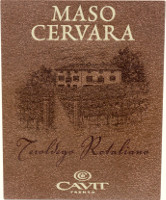
|
|
Teroldego Rotaliano Superiore Riserva Maso Cervara 2011 |
|
| Cavit (Trentino, Italy) | |
 Teroldego Teroldego | |
| Price: € 22.00 | Score: |
 Intense ruby red and nuances of ruby red, little transparency. Intense ruby red and nuances of ruby red, little transparency. Intense, clean, pleasing and refined, starts with hints of black
cherry, plum and blackberry followed by aromas of blueberry, violet,
pomegranate, tobacco, vanilla, chocolate and menthol. Intense, clean, pleasing and refined, starts with hints of black
cherry, plum and blackberry followed by aromas of blueberry, violet,
pomegranate, tobacco, vanilla, chocolate and menthol.
 Properly tannic attack and however balanced by alcohol, good body,
intense flavors, pleasing roundness. Properly tannic attack and however balanced by alcohol, good body,
intense flavors, pleasing roundness.
 Persistent finish with flavors of black cherry, blackberry and plum. Persistent finish with flavors of black cherry, blackberry and plum. 20 months in barrique, 8 months in bottle. 20 months in barrique, 8 months in bottle. |
|
 Roasted meat, Stewed and braised meat, Hard cheese Roasted meat, Stewed and braised meat, Hard cheese |
|
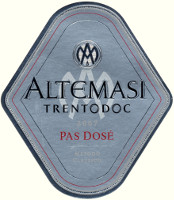
|
|
Trento Pas Dosé Altemasi 2007 |
|
| Cavit (Trentino, Italy) | |
 Chardonnay (60%), Pinot Nero (40%) Chardonnay (60%), Pinot Nero (40%) | |
| Price: € 35.00 | Score: |
 Intense golden yellow and nuances of golden yellow, very transparent,
fine and persistent perlage. Intense golden yellow and nuances of golden yellow, very transparent,
fine and persistent perlage.
 Intense, clean, pleasing, refined and elegant, starts with hints of
apple, banana and bread crust followed by aromas of plum, yeast, praline,
honey, hawthorn, butter, mineral and hints of vanilla. Intense, clean, pleasing, refined and elegant, starts with hints of
apple, banana and bread crust followed by aromas of plum, yeast, praline,
honey, hawthorn, butter, mineral and hints of vanilla.
 Effervescent and crisp attack, however balanced by alcohol, good body,
intense flavors, agreeable. Effervescent and crisp attack, however balanced by alcohol, good body,
intense flavors, agreeable.
 Persistent finish with flavors of apple, banana and plum. Persistent finish with flavors of apple, banana and plum. The base wine ages in barrique. Refermented in bottle on its lees for
72 months. The base wine ages in barrique. Refermented in bottle on its lees for
72 months.
|
|
 Pasta with fish and crustaceans, Stewed fish, Roasted white meat, Broiled crustaceans Pasta with fish and crustaceans, Stewed fish, Roasted white meat, Broiled crustaceans |
|
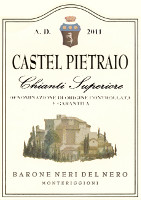
|
|
Chianti Superiore 2011 |
|
| Fattoria di Castel Pietraio (Tuscany, Italy) | |
 Sangiovese (90%), Merlot (10%) Sangiovese (90%), Merlot (10%) | |
| Price: € 4.80 | Score: |
 Brilliant ruby red and nuances of garnet red, moderate transparency. Brilliant ruby red and nuances of garnet red, moderate transparency. Intense, clean, pleasing and refined, starts with hints of black
cherry, plum and dried violet followed by aromas of blueberry, blackberry,
black currant, vanilla and carob. Intense, clean, pleasing and refined, starts with hints of black
cherry, plum and dried violet followed by aromas of blueberry, blackberry,
black currant, vanilla and carob.
 Properly tannic attack and however balanced by alcohol, good body,
intense flavors, pleasing crispness. Properly tannic attack and however balanced by alcohol, good body,
intense flavors, pleasing crispness.
 Persistent finish with flavors of black cherry, plum and blueberry. Persistent finish with flavors of black cherry, plum and blueberry. 10 months in barrique, 3 months in bottle. 10 months in barrique, 3 months in bottle. |
|
 Roasted meat, Broiled meat and barbecue, Stewed meat with mushrooms, Hard cheese Roasted meat, Broiled meat and barbecue, Stewed meat with mushrooms, Hard cheese |
|
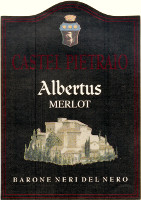
|
|
Albertus 2009 |
|
| Fattoria di Castel Pietraio (Tuscany, Italy) | |
 Merlot Merlot | |
| Price: € 12.90 | Score: |
 Intense ruby red and nuances of garnet red, little transparency. Intense ruby red and nuances of garnet red, little transparency. Intense, clean, pleasing and refined, starts with hints of black
cherry, black currant and plum followed by aromas of dried violet,
blueberry, vanilla, peony, cocoa, tobacco, leather and eucalyptus. Intense, clean, pleasing and refined, starts with hints of black
cherry, black currant and plum followed by aromas of dried violet,
blueberry, vanilla, peony, cocoa, tobacco, leather and eucalyptus.
 Properly tannic attack and however balanced by alcohol, good body,
intense flavors, pleasing roundness. Properly tannic attack and however balanced by alcohol, good body,
intense flavors, pleasing roundness.
 Persistent finish with flavors of black cherry, black currant and plum. Persistent finish with flavors of black cherry, black currant and plum. 15 months in barrique, 12 months in bottle. 15 months in barrique, 12 months in bottle. |
|
 Roasted meat, Broiled meat and barbecue, Stewed meat, Hard cheese Roasted meat, Broiled meat and barbecue, Stewed meat, Hard cheese |
|
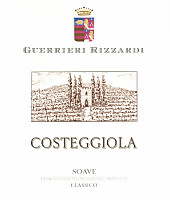
|
|
Soave Classico Costeggiola 2013 |
|
| Guerrieri Rizzardi (Veneto, Italy) | |
 Garganega (70%), Chardonnay (30%) Garganega (70%), Chardonnay (30%) | |
| Price: € 8.80 | Score: |
 Intense straw yellow and nuances of straw yellow, very transparent. Intense straw yellow and nuances of straw yellow, very transparent. Intense, clean, pleasing and refined, starts with hints of apple, plum
and hawthorn followed by aromas of citrus fruits, pineapple, peach and
almond. Intense, clean, pleasing and refined, starts with hints of apple, plum
and hawthorn followed by aromas of citrus fruits, pineapple, peach and
almond.
 Crisp attack and however balanced by alcohol, good body, intense
flavors, pleasing roundness. Crisp attack and however balanced by alcohol, good body, intense
flavors, pleasing roundness.
 Persistent finish with flavors of apple, plum and pineapple. Persistent finish with flavors of apple, plum and pineapple. Fermented in cement tanks, aged in steel tanks. Fermented in cement tanks, aged in steel tanks. |
|
 Mushroom soups, Pasta and risotto with fish, Broiled fish Mushroom soups, Pasta and risotto with fish, Broiled fish |
|
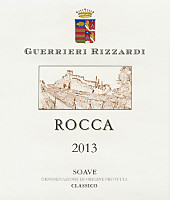
|
|
Soave Classico Rocca 2013 |
|
| Guerrieri Rizzardi (Veneto, Italy) | |
 Garganega (70%), Chardonnay (30%) Garganega (70%), Chardonnay (30%) | |
| Price: € 11.90 | Score: |
 Intense golden yellow and nuances of golden yellow, very transparent. Intense golden yellow and nuances of golden yellow, very transparent. Intense, clean, pleasing and refined, starts with hints of apple, plum
and citrus fruits followed by aromas of hawthorn, almond, ripe peach,
medlar, broom and hints of vanilla. Intense, clean, pleasing and refined, starts with hints of apple, plum
and citrus fruits followed by aromas of hawthorn, almond, ripe peach,
medlar, broom and hints of vanilla.
 Crisp attack and however balanced by alcohol, good body, intense
flavors, pleasing roundness. Crisp attack and however balanced by alcohol, good body, intense
flavors, pleasing roundness.
 Persistent finish with flavors of apple, plum and medlar. Persistent finish with flavors of apple, plum and medlar. 12 months in cask. 12 months in cask. |
|
 Pasta with fish, Mushroom soups, Stewed fish, Roasted white meat Pasta with fish, Mushroom soups, Stewed fish, Roasted white meat |
|
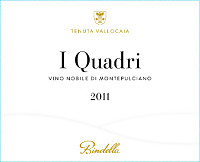
|
|
Vino Nobile di Montepulciano I Quadri 2011 |
|
| Bindella (Tuscany, Italy) | |
 Sangiovese Sangiovese | |
| Price: € 24.00 | Score: |
 Brilliant ruby red and nuances of garnet red, moderate transparency. Brilliant ruby red and nuances of garnet red, moderate transparency. Intense, clean, pleasing, refined and elegant, starts with hints of
black cherry, plum and violet followed by aromas of blueberry, raspberry,
blackberry, vanilla, chocolate, tobacco, leather, mace, pink pepper,
cinnamon and menthol. Intense, clean, pleasing, refined and elegant, starts with hints of
black cherry, plum and violet followed by aromas of blueberry, raspberry,
blackberry, vanilla, chocolate, tobacco, leather, mace, pink pepper,
cinnamon and menthol.
 Tannic attack and however balanced by alcohol, full body, intense
flavors, agreeable. Tannic attack and however balanced by alcohol, full body, intense
flavors, agreeable.
 Persistent finish with flavors of black cherry, plum and raspberry. Persistent finish with flavors of black cherry, plum and raspberry. 20 months in cask, 12 months in bottle. 20 months in cask, 12 months in bottle. |
|
 Game, Stewed and braised meat, Roasted meat, Hard cheese Game, Stewed and braised meat, Roasted meat, Hard cheese |
|

|
|
Vin Santo di Montepulciano Dolce Sinfonia 2011 |
|
| Bindella (Tuscany, Italy) | |
 Trebbiano Toscano (80%), Malvasia Bianca (20%) Trebbiano Toscano (80%), Malvasia Bianca (20%) | |
| Price: € 30.00 - 375ml | Score: |
 Brilliant amber yellow and nuances of amber yellow, transparent. Brilliant amber yellow and nuances of amber yellow, transparent. Intense, clean, pleasing, refined and elegant, starts with hints of
raisin, dried fig and honey followed by aromas of apricot jam, peach, jam,
caramel, candied fruits, quince jam, date, citrus fruits peel, walnut,
tobacco, vanilla and nail polish. Intense, clean, pleasing, refined and elegant, starts with hints of
raisin, dried fig and honey followed by aromas of apricot jam, peach, jam,
caramel, candied fruits, quince jam, date, citrus fruits peel, walnut,
tobacco, vanilla and nail polish.
 Sweet and round attack, however balanced by alcohol, full body, intense
flavors, pleasing crispness. Sweet and round attack, however balanced by alcohol, full body, intense
flavors, pleasing crispness.
 Very persistent finish with long flavors of raisin, dried fig and date. Very persistent finish with long flavors of raisin, dried fig and date. 3 years in caratelli barrels, 1 year in bottle. 3 years in caratelli barrels, 1 year in bottle. |
|
 Confectionery, Dried fruit tarts, Hard and piquant cheese Confectionery, Dried fruit tarts, Hard and piquant cheese |
|
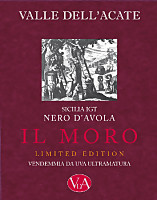
|
|
Il Moro “Limited Edition” 2008 |
|
| Valle dell'Acate (Sicily, Italy) | |
 Nero d'Avola Nero d'Avola | |
| Price: € 15.00 | Score: |
 Intense ruby red and nuances of garnet red, little transparency. Intense ruby red and nuances of garnet red, little transparency. Intense, clean, pleasing, refined and elegant, starts with hints of
blackberry, plum and black cherry followed by aromas of dried violet,
blueberry, vanilla, tobacco, cocoa, licorice, leather, tar, mace and
menthol. Intense, clean, pleasing, refined and elegant, starts with hints of
blackberry, plum and black cherry followed by aromas of dried violet,
blueberry, vanilla, tobacco, cocoa, licorice, leather, tar, mace and
menthol.
 Properly tannic attack and however balanced by alcohol, full body,
intense flavors, pleasing roundness. Properly tannic attack and however balanced by alcohol, full body,
intense flavors, pleasing roundness.
 Persistent finish with flavors of blackberry, plum and black cherry. Persistent finish with flavors of blackberry, plum and black cherry. 12 months in barrique, 60 months in bottle. 12 months in barrique, 60 months in bottle. |
|
 Game, Roasted meat, Stewed and braised meat, Hard cheese Game, Roasted meat, Stewed and braised meat, Hard cheese |
|
News |
|
In this section are published news and information about events concerning the world of wine and food. Whoever is interested in publishing this kind of information can send us a mail to our address.
|
AquavitaeReview of Grappa, Distillates and Brandy |
|
|
| Distillates are rated according to DiWineTaste evaluation method. Please see score legend in the "Wines of the Month" section. |
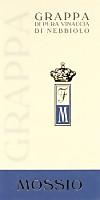
|
|
Grappa di Nebbiolo |
|
| Mossio (Piedmont, Italy) | |
| (Distiller: Distilleria Montanaro) | |
 Pomace of Nebbiolo Pomace of Nebbiolo | |
| Price: € 24.90 - 70cl | Score: |
 Pale straw yellow, limpid and crystalline. Pale straw yellow, limpid and crystalline. Intense, clean, pleasing, refined and elegant with aromas of prune,
raspberry, black cherry macerated in alcohol, vanilla, tobacco, hazelnut,
chocolate and honey with almost imperceptible alcohol pungency. Intense, clean, pleasing, refined and elegant with aromas of prune,
raspberry, black cherry macerated in alcohol, vanilla, tobacco, hazelnut,
chocolate and honey with almost imperceptible alcohol pungency.
 Intense flavors with perceptible alcohol pungency which tends to
dissolve rapidly, pleasing roundness, balanced sweetness. Intense flavors with perceptible alcohol pungency which tends to
dissolve rapidly, pleasing roundness, balanced sweetness.
 Persistent finish with flavors of prune, black cherry macerated in
alcohol, hazelnut and honey. Persistent finish with flavors of prune, black cherry macerated in
alcohol, hazelnut and honey.
 Produced with a steam operated discontinuous alembic still. Aged for
more than one year in cask. Produced with a steam operated discontinuous alembic still. Aged for
more than one year in cask.
|
|
Wine Guide ParadeJuly - August 2015
|
| |||||||
Privacy Policy | |||||||


| Copyright © 2002-2024 Antonello Biancalana, DiWineTaste - All rights reserved |
| All rights reserved under international copyright conventions. No part of this publication and of this WEB site may be
reproduced or utilized in any form or by any means, electronic or mechanical, without permission in writing from DiWineTaste. |